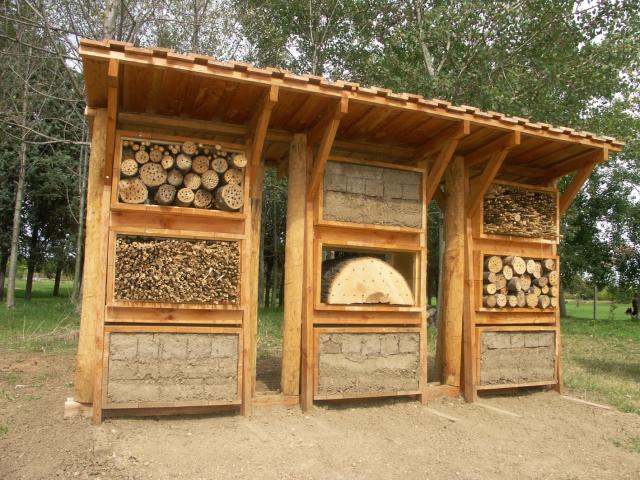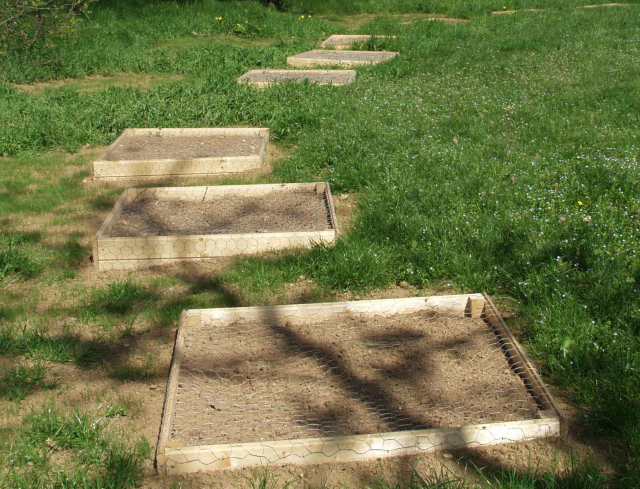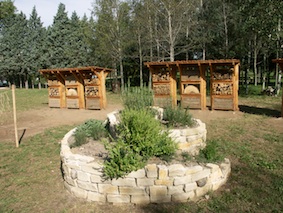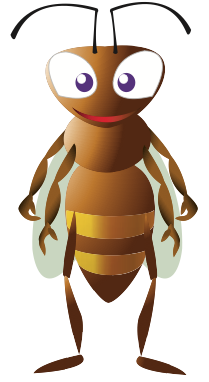- Urbanbees project
- Learn about bees
- Participate
- Download
- Contact
Actions
- The set up
- Exhibition
- Conferences
- Events in school
- Training
- Information and volunteer days
- Ways in which you can help
The set up
Nesting walls
These wooden structures, filled with logs with holes drilled into them, different kind of stems : cut cane, vine branches and dry earth, are meant to welcome a wide variety of wild bees.
- While the majority nest in the ground (role of the rammed earth), certain species nest in the holes and the cavities in the wood (role of the drilled holes)
- Others like to settle in stems such as reeds, hogweed, giant cane (as well as, bambou, knotgrass…)
- And some species nest inside branches with soft centres by digging a custome-made hole. The types of branches used are bramble, raspberry bush, elder or buddleja (butterfly bush)…
The choice of material for nesting plays an important role in the settling of wild bees, but it is not the only deciding factor. Bees need warmth to function and to develop. The different exposures of these hotels (either exposed to, or, sheltered from wind and sunlight) help us better understand their needs.
Squares of soil
Simple square wooden frames, filled with a mix of soil, sand and clay, are made to serve as homes for numerous wild bees who prefer to nest underground (80 %).
- In order to refine our knowledge on the exact types of ground prefered for nesting, different mixtures are used for each square.
- The 50 cm-deep wooden frames are not within reach of nearby roots. They warm the surrounding area. A layer of pebbles at the bottom of the frame helps drain off rain.
- Chicken wire protects the earth walls from cat excrement and from burrowing rabbits.
Also, any plant growth is taken away manually. All these measures have been taken to create the conditions, as similar as possible to those of wild bees nesting in natural habitat.
Herb and Insects Spiral

This wall of dry stones built in a spiral shape helps to warm and dry light soil. This structure favours the growth of Mediterranean aromatic plants and nectariferous plants that bees love. Temperature and hygrometry differ between the top and the base of the spiral.
---at the top, where the soil is the driest, lavander, hyssop, savory, thyme, rosemary, common rue, Aegean wallflower, red valerian, and sedum, for example, can be planted
---a little lower, burnet, pyrethrum, and borage thrive along the slope
---at the base, where the soil is cooler and more nutrient rich, dill, oregano, basil, chives, mint, lemon balm flourish
The stones of the spiral are deliberately placed with wide spaces between them and set with lime, in order to welcome other living creatures (ladybirds, spiders, hedgehogs, lizards, etc). The spiral offers homes and food to a multitude of small creatures by making maximum use of a small area (2 to 4 metres in diametre). This design is not only useful but pleasant to the eye.
Exhibition
Urbanbees is a travelling exhibition, geared for the general public. It is in 3 langages : french, english and german.
It talks about the phenomena of the disappearance of wild bees, its consequences with regards to the way we live, and how we can participate in the safekeeping of these threatened species. Wild bees, essential in maintaining the biological balance of the planet, are disappearing. Unnoticeably, by discretely gathering nectar here and there, these pollinators allow many vegetal species to perpetuate themselves, thus doing us an inestimable favour by preserving our environment, and a part of our natural resources.
Conferences
Going one step further than the exhibition, public debates held in cafés and public conferences are organised in order to explain the stakes, the goals and the work of the Urbanbees programme for the conservation of wild bees. The screening of the documentary "The Strange Disappearance of the Bees" by Mark Daniels followed by a public debate could be a possible outreach event. These conferences are run by a member of the Arthropologia Association. We plan for a minimum of 50 participants for each conference. In 2014, conferences in Europe allow the Urbanbees land management proposal to be more widely known.
Events in school
Outreach programmes in primary and secondary schools are planned. The content and the teaching materials are provided by the Arthropologia Association in cooperation with the city of Lyon. The diversity of bees, pollination, and the importance of their conservation with respect to nature and the food chain for humans, are the types of themes that are addressed.
The events in primary school
In primary schools, our bee-education visits are geared for pupils aged 8 to 11. Our intervention intergrates the general pedagogical aims of the pupils and priority is given to schools situated near an UrbanBees study site. For primary schools, our visits last 3 half-days. Before and after each visit, the teacher are responsible for preparing the pupils with basic knowledge on the theme ahead of time, and follow up. The pupils are accompanied to the Urbanbees study site during the second or third session. At the end of the three sessions, the school has a small bee observatory at its disposal in order for the pupils to continue to learn about these indispensable pollinators. In order for the pupils to fully appreciate the observatory after our 3-day intervention, our visits will take place in primary schools from September until the end of April.
The events in secondary schools
The format of our presentations in secondary schools is one hour minimum to a half-day maximum. The presentations can take place in the classroom, or, at one of the UrbanBee study sites, if possible.
Training
One of the aims of the programme is to bring about change in green space management favouring wild bees and nature in general. These training sessions are geared for municipal green space professionals, farmers, landscape architects or agriculture students. The training course entitled "Managing the Diversity of Pollinators : Nesting and Reproduction" is adapted to suit the learners in question.
This course lasts two days, and its aims are:
- to provide information about the diversity of living creatures, most notably pollinators, flowering plants and their relationship
- to identify flower-dependant insects and pollinators, and the main auxiliary groups and destructive neighbours
- to highlight the causes of the disappearance of the diversity of living creatures and specifically the decline of pollinators
- to update the notion of the cycle of life, the primordial role of nesting and feeding zones, the roles and workings of residual natural spaces: hedges, embankments, rocky land, ponds, fallow land, waste land, ecotones
- to teach how to maintain the populations of pollinators, by helping them naturally and artificially: land management, building certain structures, planting certain flowers
The content is developped in theory and practice: theory and practice work in the classroom, followed by field work. This training course, presented with a naturalist approach, is taught by Hugues Mouret and by Frederic Vyghen from Arthropologia.
Information Days
At each study site, there is an inauguration day with elected officials and the general public. At sites where there is a permanent exhibition (Parc de la Tête d'Or, Parc de Gerland in Lyon, and Léon Chomel Garden in Villeurbanne) information days will be organised every year.
Ways in which you can help
For those who wish to participate in the programme, three levels of implication have been defined and have been set up as of autumn 2010.
Level one
This is coordinated by Arthropologia.
You are interested in the project, but you do not want to participate in an active manner:
- sign up on a mailing list that will keep you informed of events
- participate during volunteer days at Urbanbees study sites where we prepare the material for filling the bee hotels
- receive by email or by post our guide of responsible land management for your garden or green space
- post your best bee photos on the Urbanbees site and help us fill our photographic data base. This collection of photos will not, however, be able to be used for identification ; only a few rare species (less than ten) can be identified this way. Photo contests will be organised on a regular basis.
Level two
You would like to participate more actively and set up the necessary structures (in private gardens or in municipalities):
Providing a nesting site in your garden is coordinated by Arthropologia.
A charter about responsible gardening and pedagogical materials is accessible on the Urbanbees site. You will be able to test alternative ways of gardening, and set up nest boxes outside*. You will be able to, thereafter, take note of the occupied nests. Your complementary data would be of help for our research on bee ecology. If the owners agree, certain nest boxes in gardens will be checked during outings on the field.
*: private nest boxes would be added to the map of the network of ecological corridors in Gand Lyon
Providing a nesting site in your town*, is coordinated by the University of Lyon.
People would be invited to a workshop in order to plan, and learn about creating the bee hotels for public places in the town. The workshop would be organised as follows, for each group of people interested in, and registered for the project:
- learning about wild bees at existing study sites with a naturalist guide from Arthropologia
- a jovial presentation, led by a mediator from the University of Lyon, about how we perceive pollinating insects in our society (fear, disgust....) nd the cultural causes of this negative impression. It would be a moment of reflexion and exchange on our relationship between nature and the environment, on the impact of our daily lifestyle and factors on the decline of wild bees and biodiversity
- making a bee hotel with the help of an artist. The form of the nesting site will be adapted to the urban environment in which it will be placed. It will play a role of mediation in the town since it will integrate the questions and the phrases chosen by the group, the result of self-questioning and games. This structure will help passers-by become aware of the decline of wild bees and provoke a holistic change in day-to-day behaviour. Participants will then be able to create nesting sites in their own gardens, balconies, and will be encouraged to plant bee-friendly varieties of vegetation. The people who would take on such initiatives would become somewhat like "embassadors" of the cause within their communities, and thereby, promote the project and bring awareness to others.
Registration is mandatory and numbers are limited
*public spaces outside of parks.
Level three, is coordinated by Arthropologia.
You want to implicate yourself in the scientific project => participative science.
You would be eligible for a training session on the identification of families and main bee genera, and on the preparation of specimens for identification.
- training in classroom : theory and practice
- training outside of the classroom : outings to observe wild bees, learning methods of capture and identification
- participation in preparation sessions (mounting and labelling..)
- observation and monitoring of some target species (easily identifiable)
- participation in the compiling of data on flower/bee ratios
- participation during data collection days for those who are most keen.


